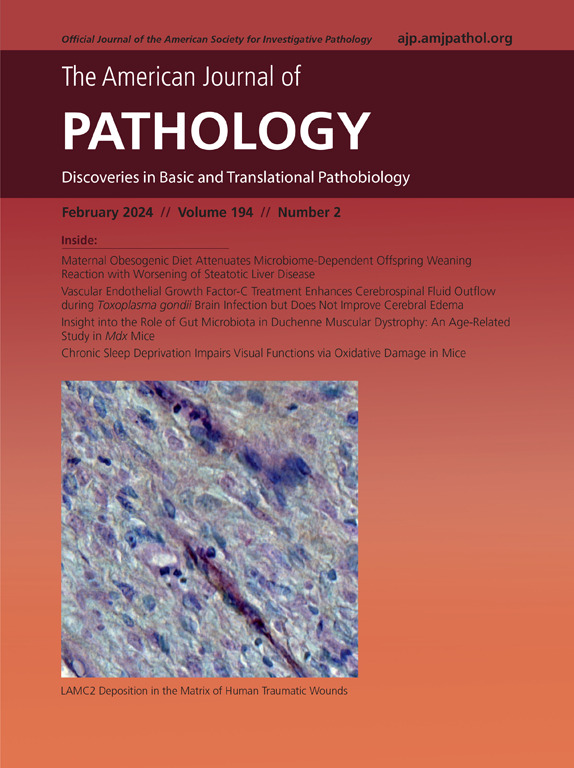黑色素瘤和细胞外囊泡中的 PD-L1 通过 M2 样巨噬细胞极化促进局部和区域免疫抑制。
IF 3.6
2区 医学
Q1 PATHOLOGY
引用次数: 0
摘要
肿瘤相关巨噬细胞(TAMs)在肿瘤进展中表现出双重作用。众所周知,TAMs 能诱导癌细胞中 PD-L1 的表达。然而,黑色素瘤细胞中的PD-L1对TAM表型转换的调控作用仍未得到充分探索。在此,我们的研究结果表明,与原发性黑色素瘤相比,转移性黑色素瘤中的CD163和MRC1水平显著升高,与CD274表达相关,并可预测患者的临床预后。为了研究M2样极化的调控机制,我们在YUMM1.7和B16-F10黑色素瘤细胞中敲除了PD-L1。数据显示,与野生型(WT)黑色素瘤细胞相比,敲除黑色素瘤细胞中的PD-L1(PD-L1KO)会导致体内生长速度减慢,同时M1/M2比例显著增加,树突状细胞增多,CD8+ T细胞活化增强。这些变化与 M2 相关趋化因子(CCL2、CCL3 和 CXCL2)和细胞因子(IL6、IL10 和 TGFβ1)的表达减少有关。与患有 PD-L1WT 黑色素瘤的小鼠相比,患有 PD-L1KO 黑色素瘤的小鼠在肿瘤引流淋巴结和血液中的 CD8+ T 细胞水平都有所升高。与来自 PD-L1WT 黑色素瘤的细胞外囊泡 (EVs) 相比,用来自 PD-L1KO 黑色素瘤的细胞外囊泡 (EVs) 治疗可降低肿瘤生长率,减少肿瘤中的 M2 样巨噬细胞。因此,我们的数据表明,黑色素瘤和黑色素瘤衍生的EVs中的PD-L1会诱导M2样极化,从而导致局部和区域性免疫抑制。本文章由计算机程序翻译,如有差异,请以英文原文为准。
Programmed Death Ligand-1 in Melanoma and Extracellular Vesicles Promotes Local and Regional Immune Suppression through M2-like Macrophage Polarization
Tumor-associated macrophages (TAMs) play dual roles (both pro- and antitumor) in tumor progression. TAMs induce programmed death ligand-1 (PD-L1) expression in cancer cells. However, the regulatory effects of PD-L1 in melanoma cells on TAM phenotypical switching remain underexplored. Herein, CD163 and MRC1 levels were significantly elevated in metastatic melanomas compared with those in primary melanomas, correlating with CD274 expression and predicted patient clinical outcomes. To study the mechanisms regulating M2-like polarization, PD-L1 was knocked out in both YUMM1.7 and B16-F10 melanoma cells. Knocking out PD-L1 (PD-L1KO) in melanoma resulted in a decelerated in vivo growth rate, accompanied by a significantly increased M1/M2 ratio, more dendritic cells, and enhanced activation of CD8+ T cells compared with wild-type (WT) melanoma cells. These alterations were associated with decreased expression of M2-associated chemokines (CCL2, CCL3, and CXCL2) and cytokines (IL6, IL10, and TGFB1). Mice harboring PD-L1KO melanomas exhibited elevated levels of CD8+ T cells in both the tumor-draining lymph nodes and the bloodstream compared with mice with PD-L1WT melanomas. Treatment with extracellular vesicles (EVs) derived from PD-L1KO melanoma resulted in a reduced tumor growth rate and fewer M2-like macrophages in the tumors compared with EVs from PD-L1WT melanomas. Therefore, these data suggest that PD-L1 in melanoma and melanoma-derived EVs induces M2-like polarization, contributing to local and regional immune suppression.
求助全文
通过发布文献求助,成功后即可免费获取论文全文。
去求助
来源期刊
CiteScore
11.40
自引率
0.00%
发文量
178
审稿时长
30 days
期刊介绍:
The American Journal of Pathology, official journal of the American Society for Investigative Pathology, published by Elsevier, Inc., seeks high-quality original research reports, reviews, and commentaries related to the molecular and cellular basis of disease. The editors will consider basic, translational, and clinical investigations that directly address mechanisms of pathogenesis or provide a foundation for future mechanistic inquiries. Examples of such foundational investigations include data mining, identification of biomarkers, molecular pathology, and discovery research. Foundational studies that incorporate deep learning and artificial intelligence are also welcome. High priority is given to studies of human disease and relevant experimental models using molecular, cellular, and organismal approaches.

 求助内容:
求助内容: 应助结果提醒方式:
应助结果提醒方式:


